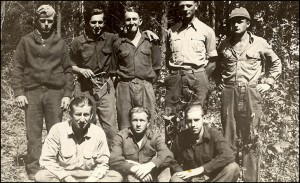The below exhibit will be shown from 3 March through 24 April 2016 in the Stadtmuseum Weimar (Karl-Liebknecht-Straße 5, 99423 Weimar; tel. 0049.3643.82600); for further information: stadtmuseum@stadtweimar.de. It was shown from 19 March through 23 April 2015 in the Center for American Studies (HCA) of the Universität Heidelberg (Hauptstrasse 120, 69117 Heidelberg; tel. 0049.6221.543710); for further information: hca@uni-hd.de
For additional information, contact staff@TRACES.org.
Behind Barbed Wire: German and American Prisoners of War in World War II
In World War II the western Allies captured hundreds of thousands of German soldiers. They shipped some 380,000 of them to North America, where they were imprisoned in over 600 base and branch camps.
German Prisoners of War (POWs) in Minnesota, circa 1944
At the same time, about 90,000 U.S. American Prisoners of War were in the Third Reich, where they suffered as much as if not more than the German civilians among whom they found themselves.
In the nights of the bombing of Dresden—just before the war’s end—there were tens of thousands of Allied POWs, as well as concentration-camp inmates and German refugees in the Saxon capital. Immediately after the bombing, the POWs had the task of digging the uncountable corpses from the destruction of the famed “Florence on the Elbe” from mountains of soot and ashes, stack them in piles and burn them.
Before Kurt Vonnegut died, he worked with TRACES, an American non-profit educational organization, to tell once more the story that forms the core of his Slaughterhouse Five, which tells of his having survived the firestorm over Dresden, unleashed by his own compatriots.
Now the stories of German POWs in the United States, as well as those of American POWs in the Third Reich can be told in an exhibit form, titled Behind Barbed Wire (Hinter dem Stacheldraht). For further information, contact staff@TRACES.org.
